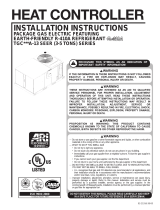
7
ROUTINE MAINTENANCE
D
ISCONNECT MAIN ELECTRICAL
POWER TO THE UNIT BEFORE
ATTEMPTING ANY
MAINTENANCE. FAILURE TO DO
SO CAN RESULT IN SEVERE
ELECTRICAL SHOCK OR DEATH.
Routine maintenance to be
p
rovided by a qualified installer,
service agency or the gas supplier
ONLY.
COMBUSTION AREA AND
EXHAUST SYSTEM
1. It is recommended that an annual
inspection of your furnace be
done by a qualified installer,
service agency or the gas
supplier.
2. Turn OFF the electrical supply to
the furnace and remove the
access doors.
3. Inspect the gas burners and
burner compartment for dirt, rust,
or scale.
IF DIRT, RUST, SOOT OR SCALE
ACCUMULATIONS ARE PRESENT,
DO NOT OPERATE THIS
FURNACE. INSPECT THE HEAT
EXCHANGERS FOR LEAKS.
LEAKS CAN CAUSE TOXIC
FUMES TO ENTER THE HOME
AND CAUSE INJURY OR DEATH.
4. Inspect the exhaust area inside
and outside the appliance
including the exhaust transition
piece and the exhaust hood. Be
sure that the exhaust transition
piece (inside the appliance) and
the hood are in place and are
physically sound, without holes
or excessive corrosion. If these
components have deteriorated,
have a qualified service
professional replace them using
factory specified or approved
replacement parts only.
5. Be sure that the return air duct
connections are physically sound
and are sealed to the unit.
6. Look for obvious signs of
deterioration of the unit.
7. If the unit is free of the above
conditions, replace all access
doors, except furnace access
p
anel, and restore electrical
power to the unit.
8. Make sure control box cover is in
place. Start the furnace and
observe its operation. Watch the
burner flames to see if they are
bright blue. If a suspected
m
alfunction is observed, or the
burner flames are not bright blue,
apply appropriate service.
EXAMINATION OF
INSTALLATION
1. The combustion air inlets and
combustion air outlets must be
clear and free of obstructions.
2. The return and supply duct
connections should be physically
sound and sealed where they
connect to the unit.
3. Check for obvious signs of
deterioration of the unit.
4. CONDENSATE DRAIN — Check
annually and, if necessary, clean
drain pan and drain line. See
Figures 1 and 2 for location of
drain lines. In winter, keep drain
and trap dry or protect against
freeze-up.
5. The blower compartment and
motor should be inspected and
cleaned periodically by your
qualified installer, service agency
or the gas supplier to prevent the
possibility of overheating due to
an accumulation of dust and dirt
on the windings or on the motor
exterior. And, as suggested
elsewhere in these instructions,
the air filters should be kept
clean because dirty filters can
restrict airflow and the motor
depends upon sufficient air
flowing across and through it to
keep from overheating.
6. Perform the examination
annually to insure proper
operation.
FILTER MAINTENANCE
Have your qualified installer, service
agency or the gas supplier instruct
you on how to access your filters for
regular maintenance.
DISCONNECT THE MAIN POWER
TO THE OUTDOOR UNIT BEFORE
A
TTEMPTING ANY MAINTENANCE
OPERATION. FAILURE TO DO SO
CAN RESULT IN SEVERE
ELECTRICAL SHOCK OR DEATH.
1. Keep air filters clean. There are
several types of material used in
air filters and there are many
possible locations for air filters.
Consult with your contractor as to
the locations of the filters and
type of material in use.
2. How To Clean:
Glass Fiber (Throwaway) —
This is a disposable type of filter.
Inspect monthly and replace
when necessary. A new home or
building will normally require
more frequent attention to the
filters.
Aluminum Mesh — Wash with
detergent and water. Air dry
thoroughly and renew the coating
in compliance with the
manufacturer’s instructions.
Plastic Impregnated Fiber —
Wash with detergent and water
or vacuum clean, then reinstall.
IMPORTANT: Do not operate
your system for extended
periods without filters, as the
dust entrained in the air may
pack into the fin area of the
evaporator coil creating a
condition which could require
extensive repairs.
!
WARNING
!
WARNING
!
WARNING








